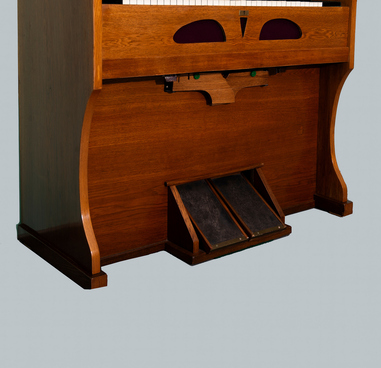In 1889, the Swedish organ builder and entrepreneur Theodor Mannborg came to the German town of Borna with two assistants, Lars Magnus Hofberg and Olof Lindholm. Lindholm worked for Mannborg, but when the latter decided to move production to Leipzig, he stayed in Borna and established his own factory in 1894.
In 1911, Lindholm retired and sold the factory to Gustav Weischet, who operated a reed organ retail business. In 1972, Lindholm was taken over by the government monopoly, which had been renamed VEB Deutsche Piano-Union Böhlitz-Ehrenberg, and the manufacturing was moved to Leipzig.
The spinet is a type of harpsichord for home use. It has a single keyboard and one row of strings that run diagonally from left to right at an angle of 30 degrees to the keyboard. When a key is pressed, a hook attached to a special rod plucks the string. The keyboard range is four and a half octaves (C–F). The modern spinet is equipped with two stops, one of which imitates the sound of the lute.
This musical instrument has been known in Italy since the early 15thcentury. Early models were pentagonal or hexagonal instruments with a keyboard on the longest side. Later, wing-shaped spinets appeared. They gained recognition but were superseded by the piano. In the 20thcentury, interest in early music brought the spinet back to the stage.
In Barnaul, Yemelyan Katz was the first musician to popularize the music of the 16th–18thcenturies; on his initiative, the displayed spinet was purchased for the city’s music school.
Among other old instruments, the Lindholm spinet was played at concerts of the chamber orchestra conducted by Yemelyan Katz and the “Ars longa” ensemble led by Vladimir Anisimov.
The “Ars longa” ensemble toured extensively
throughout Russia and Europe, participating in international festivals of early
music in Moscow, Novosibirsk, and Zielona Góra, Poland. One of the last “Ars
longa” projects was the program “Masterpieces of the Past Millennium”,
successfully presented in Germany in 2000. In December 2015, the spinet was
used as a solo instrument in the oratorio “St. Mark Passion”. As part of the
“Siberian Seasons” festival, this masterpiece by Johann Sebastian Bach, which
had previously been considered lost, was performed for the second time in
Russia and the third time in the world on the stage of the Altai Philharmonic.




